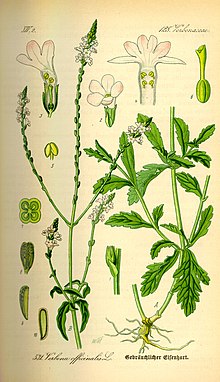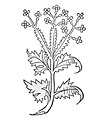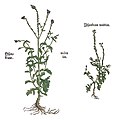Real verbena
| Real verbena | ||||||||||||
|---|---|---|---|---|---|---|---|---|---|---|---|---|

Verbena ( Verbena officinalis ) |
||||||||||||
| Systematics | ||||||||||||
|
||||||||||||
| Scientific name | ||||||||||||
| Verbena officinalis | ||||||||||||
| L. |
The real verbena ( Verbena officinalis ), short- verbena , and ragweed , cat blood herb , Say herb , Verbena or desire herb called, is a species that for species of verbena ( Verbena belongs). It is a traditional medicinal plant .
description
Appearance and foliage leaf
Verbena grows as a deciduous, rarely annual to usually short-lived herbaceous plant that reaches heights of 20 to 75 cm. The upright, branched stem is square and downy hairy to almost bald. The leaves are arranged opposite one another on the stem. The leaf blade narrows to a 0.3 to 4 cm long petiole. The 2 to 8 cm long and 1 to 5 cm wide, egg-shaped, obovate or elongated leaf blade is paper-like, particularly hairy on the leaf veins on the underside of the leaf. The leaf blade is roughly toothed, lobed to sometimes deeply pinnate.
Generative characteristics
In thyrsen there are slender, year-old partial inflorescences. The bracts are as long as the calyx.
The relatively small, hermaphrodite flowers are zygomorphic and five-fold with a double flower envelope . The five 1 to 4 mm long sepals are fused and hairy glandular and downy. The five whitish to reddish, light purple to bluish, downy-haired petals are fused into a (2 to) usually 4 to 8 mm long corolla tube, the coronet is two-lipped and presentation plate-shaped. There are four fertile stamens , two longer and two shorter ones. The ovary is bare.
The Klausen fruit breaks up into four elongated, 2 mm long Klausen.
Phenology
The flowering period in Central Europe extends from May to October, or until the first frost. The fruits ripen between July and October.
Chromosome number
The number of chromosomes is 2n = 14.
ecology
Verbena is a semi-rosette plant that sits up to 60 cm deep in the ground with its spindle-shaped, branched roots.
The flowers are homogamous "lip flowers". Nectar is secreted by the discus in the flower and covered by a hair ring. The pollen is emptied from 7 a.m. to 12 p.m. (rarely until 2 p.m.). The flowers are pollinated by bees. Self-pollination is also successful.
The upright inclined goblet encloses the Klausen, serves as a vestibule and falls away with it when it is ripe. The real verbena is therefore a wind and animal spreader ; Adhesive spreading and human spreading are also possible. The verbena becomes a cultural relic through the spread of treads.
Occurrence
Verbena is found in temperate and tropical areas around the world. It is an invasive plant in many countries .
Verbena appreciates sunny, sheltered locations with moderately nutrient-rich and slightly acidic, sandy loam and clay soils and has a high water requirement in summer. It is an inconspicuous, but perennial plant and likes to grow on paths, hedges and debris.
Verbena is a species of the class creeping ostrich lawn and flood lawn ( Agrostietea stoloniferae ). But it also occurs in societies of the associations Polygonion avicularis or Arction lappae. It is an old immigrant ( archaeophyte ) in Central Europe : As a cultural companion or as a cultural relict it has been z. B. in the vicinity of human settlements or castles detectable. In the Allgäu Alps it rises to an altitude of 1100 meters.
Systematics
The first publication of Verbena officinalis was made in 1753 by Carl Linnaeus in Species Plantarum . A synonym for Verbena officinalis L. is Verbena setosa M. Martens & Galeotti .
There are two varieties:
- Verbena officinalis var. Africana (R.Fern. & Verdc.) Munir : It occurs in the western Mediterranean area and from northeastern tropical Africa to southern Africa and to Australia. In New Zealand she is a neophyte .
- Verbena officinalis var. Officinalis : It is native to the temperate and subtropical zones of Europe, Asia, Australia and Africa and is a neophyte in North, Central and South America and New Zealand.
use
The real verbena is offered as a basis for cosmetic products, as tea and as an alcoholic drink. Its name is often confused with lemon verbena, which is also part of the iron herb family ( Aloysia citrodora ), which is often sold under the misleading names "fragrant verbena" or "fragrant verbena". A differentiation is possible by smell and taste. While the lemon verbena smells and tastes intensely of lemon, the real verbena smells rather inconspicuous and contains many bitter substances .
Verbena in herbal medicine
The real verbena, also briefly verbena (from Middle High German īsenkrūt called) has, especially in herbal medicine has a long tradition going back to the ancient times goes back. In particular , it was said to have diuretic , bile flow- stimulating and anti- rheumatic effects. As ingredients that could iridoid - glycosides verbenalin, Hastatosid and other compounds besides a number also verbascoside be detected. However, the plant does not contain iron. Despite multiple pharmacological investigations of all known ingredients, a clear pharmaceutical effect could not be proven with certainty. That is why verbena preparations are only used in folk medicine today, if at all . Verbena is an essential part of common cold remedies.
More recent studies also show sleep-promoting and neuroprotective effects of the ingredients.
Verbena tea and oils are considered to be a labor-inducing agent.
Verbena as a cultural symbol
Verbena has been used cultically since the earliest times . Verbena was already used in Indo-European ceremonies to clean sacrificial stones or altar tables. In ancient Egypt , the plant called the tear of Isis was used in ceremonies. In ancient Greece it was assigned to the goddess of the dawn Eos Erigineia , in ancient Rome , according to Pliny, verbena was always in bundles on the altar of Jupiter .
In Wales the verbena is called Devil's bane (" Devil's spell ").
The name verbena (Middle High German īsenkrūt ) itself can be attributed to the ritual use of this plant traced: You should be the best remedy for wounds be by iron weapons, and it was in the iron smelting added.
In southern Europe in particular, verbena was deeply rooted in superstition . The ancient Romans used verbena to describe certain parts of plants that were used in ceremonies and in medicine . Even in the Middle Ages , the herb was part of summoning ceremonies .
Verbena as a luxury food
In the region around Le Puy-en-Velay in southern France , a schnapps with a digestive effect is produced under the name Verveine du Velay . However, "verveine" here refers to the lemon verbena ( Aloysia citrodora ), which, in contrast to verbena, has a lemony scent . Lemon verbena is also usually meant in connection with tea enjoyment (and with enjoyment in general). This is also the case with the “verveine menthe” tea blend that is widely used in Arab countries.
history
Dioscurides and Pliny distinguished between an "upright peristerion" and a "recurved peristerion". These were interpreted by the fathers of botany as true verbena ("upright peristerion - verbena little man") and as rocket ("bent back peristerion - verbena woman").
The same effects were ascribed to both types: driving away pain from the uterus, healing of skin diseases and wounds, jaundice, three-day fever and four-day fever, and the effects of snake and dog bites.
The plant was to be harvested with a ceremony in which iron was to be drawn around it. Pliny reported extensively on the cultic use of the plant by the Romans and Gauls.
swell
- Antiquity - late antiquity: Pedanius Dioscurides , 1st century --- Pliny , 1st century --- Galenus , 2nd century --- Pseudo-Apuleius , 4th century
- Latin Middle Ages: Macer floridus , 11th century --- Galangal and spices treatise , 14th century --- Konrad von Megenberg , 13th century --- Michael Puff 1481 --- Nikolaus Frauenlob , 15th century --- Gart der Gesundheit 1485 --- Hortus sanitatis 1491 --- Hieronymus Brunschwig , 1500
- 16th century: Otto Brunfels 1532. --- Hieronymus Bock 1539 --- Leonhart Fuchs 1543
Historical illustrations
Vienna Dioscurides 6th century
Vienna Dioscurides 6th century
Pseudo-Apuleius Leiden 6th century
Vitus outlet 1479
Hortus sanitatis 1491
Otto Brunfels 1532
Leonhart Fuchs 1543
Leonhart Fuchs 1543
swell
- Saiyad Masudal Hasan Jafri, Abdul Ghafoor: Flora of West Pakistan 77: Verbenaceae . Stewart Herbarium, Rawalpindi 1974, p. 4 ( online ). (Section description).
- Shou-liang Chen, Michael G. Gilbert: Verbena. In: Wu Zheng-yi, Peter H. Raven (Ed.): Flora of China . tape 17 : Verbenaceae through Solanaceae . Science Press / Missouri Botanical Garden Press, Beijing / St. Louis 1994, ISBN 0-915279-24-X , pp. 3 (English). , online. (Section description)
- Real verbena. In: FloraWeb.de. (Sections Description and Occurrence)
Individual evidence
- ↑ a b c Ruprecht Düll , Herfried Kutzelnigg : Pocket dictionary of plants in Germany. A botanical-ecological excursion companion to the most important species . 6th, completely revised edition. Quelle & Meyer, Wiebelsheim 2005, ISBN 3-494-01397-7 .
- ↑ a b c Siegmund Seybold (Ed.): Schmeil-Fitschen interactive . CD-ROM, version 1.1. Quelle & Meyer, Wiebelsheim 2002, ISBN 3-494-01327-6 .
- ^ Erich Oberdorfer : Plant-sociological excursion flora for Germany and neighboring areas . With the collaboration of Angelika Schwabe and Theo Müller. 8th, heavily revised and expanded edition. Eugen Ulmer, Stuttgart (Hohenheim) 2001, ISBN 3-8001-3131-5 , pp. 788-789 .
- ↑ Heinz Ellenberg : Vegetation of Central Europe with the Alps in an ecological, dynamic and historical perspective (= UTB for science. Large series . Volume 8104 ). 5th, heavily changed and improved edition. Eugen Ulmer, Stuttgart (Hohenheim) 1996, ISBN 3-8252-8104-3 .
- ↑ Erhard Dörr, Wolfgang Lippert : Flora of the Allgäu and its surroundings. Volume 2, IHW, Eching 2004, ISBN 3-930167-61-1 , p. 384.
- ↑ Carl von Linné: Species Plantarum. Volume 1, Impensis Laurentii Salvii, Holmiae 1753, p. 20, Verbena
- ↑ Verbena officinalis at Tropicos.org. Missouri Botanical Garden, St. Louis
- ↑ a b c Rafaël Govaerts (Ed.): Verbena officinalis. In: World Checklist of Selected Plant Families (WCSP) - The Board of Trustees of the Royal Botanic Gardens, Kew . Retrieved February 4, 2016.
- ↑ Heinrich Marzell: Dictionary of German plant names. Volume 4, p. 1046 f.
- ↑ Max Wichtl (Ed.): Tea drugs and phytopharmaceuticals. A handbook for practical use on a scientific basis . 4th, exp. and completely revised Edition. Wissenschaftliche Verlagsgesellschaft, Stuttgart 2002, ISBN 3-8047-1854-X .
- ↑ Yuki Makino, Shino Kondo, Yoshiko Nishimura, Yoshinori Tsukamoto, Zhi-li Huang, Yoshihiro Urade Yuki: Hastatoside and verbenalin are sleep-promoting components in Verbena officinalis. In Sleep and Biological Rhythms. Volume 7, No. 3, 2009, 211-217, doi: 10.1111 / j.1479-8425.2009.00405.x .
- ↑ Sau-Wan Lai, Man-Shan Yu, Wai-Hung Yuen, Raymond Chuen-Chung Chang: Novel neuroprotective effects of the aqueous extracts from Verbena officinalis Linn. In: Neuropharmacology . Volume 50, No. 6, 2006, pp. 641-650, doi: 10.1016 / j.neuropharm.2005.11.009 , PMID 16406021 .
- ↑ http://www.hebammenwissen.info/geburt-natuerlich-einleiten/
- ↑ http://www.schwanger-online.de/medizinischer-ratgeber/wehenfoerdernd
- ↑ Urania - weekly for popular education. Volume 5, 1915 ( limited preview in Google Book Search).
- ↑ Florian von Heintze: Plants and Environment. Wissenmedia Verlag, 2006, ISBN 978-3-577-07555-8 , p. 160 ( limited preview in Google book search).
- ↑ Jacobus Theodorus: Herbal Book. Published by Johann Ludwig Königs, booksellers, of the time in Offenbach am Mayn, 1731, p. 383 ( limited preview in the Google book search).
- ↑ Julius Berendes: Des Pedanius Dioskurides medicament theory in 5 books. Enke, Stuttgart 1902, Book IV, Cap. 60 (Peristeron), Book IV, Cap. 61 (bent back peristeron) (digital copy)
- ↑ Pliny . Naturalis historia , Volume XXV, §105 (Chapter LIX): Edition Külb 1840–1864 German (digitized version )
- ↑ Galenus . De simplicium medicamentorum temperamentum ac facultatibus. (Kühn edition, vol. XII, p. 98) Peristeron, Verbena (digitized version)
- ↑ Ernst Howald and Henry E. Sigerist . Antonii Musae De herba vettonica, Liber Pseudo-Apulei herbarius, Anonymi De taxone liber, Sexti Placiti Liber medicinae ex animalibus. Corpus medicorum latinorum Vol. IV , Teubner, Leipzig 1927, Cap. 3 Herba Verbenaca.
- ↑ Macer floridus , 11th century, printed in Basel 1527 (digitized version)
- ↑ Galangal spice treatise , 14th century (Heidelberg Cpg 620, recipe collection - Northern Bavaria around 1450, sheet 89v-90v, Eisenkraut, Verbena (digitized version ) )
- ^ Franz Pfeiffer (ed.). Konrad von Megenberg . Book of nature . Stuttgart 1861, p. 424. (digitized version )
- ↑ Michael Puff . Little book about the burnt-out waters . (15th century). Printed in Augsburg (Johannes Blaubirer) 1481 (digitized version ) .
- ↑ Nikolaus Frauenlob . Pharmacopoeia. (15th century) manuscript census. Frauenlob, Nikolaus: Pharmacopoeia. Cpg 583, sheets 23r-24r digitized ; Cpg 666, sheet 120v-121v (digitized) .
- ↑ Gart der Gesundheit , Mainz 1485, Chapter 412 (digitized version)
- ↑ Hortus sanitatis , Mainz 1491, De herbis, chapter 486. (digitized version )
- ↑ Hieronymus Brunschwig . Small distilling book . Strasbourg 1500, sheet 61v-62r (digitized version )
- ^ Otto Brunfels : Contrafeyt Kreüterbuch. Strasbourg 1532, p. 47 (digitized version) .
- ↑ Hieronymus Bock : New Kreütter book. Strasbourg 1539, book I, cap. 32: Senff and Raucken ("das sibent Senff kraut, verbena das Weiblin") (digitized version ) ; Book I, cap. 69, Verbena (digitized version)
- ↑ Leonhart Fuchs . New Kreütterbuch. Basel 1543, Cap. 226 (digitized version)
- ↑ Left: "Ysen herb masculine" ( Verbena officinalis ). Right: "Isenkraut Weiblin" ( Sisymbrium officinale )
Web links
- Real verbena. In: FloraWeb.de.
- Verbena officinalis L. In: Info Flora , the national data and information center for Swiss flora . Retrieved February 13, 2016.
- Thomas Meyer: Eisenkraut data sheet with identification key and photos at Flora-de: Flora von Deutschland (old name of the website: Flowers in Swabia )
- Datasheet at Botanik im Bild / Flora von Österreich , 2002.
- Bavarian State Institute for Agriculture. Culture guide for verbena. Digitized












